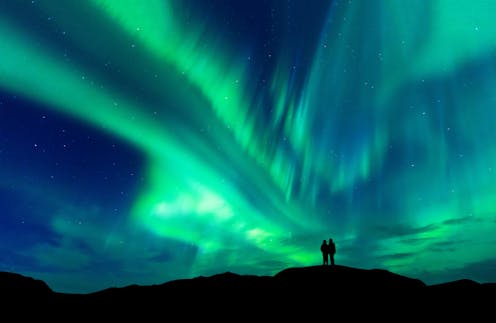
People across the UK, from the Shetland Islands to Somerset and from Norfolk to Northern Ireland, have been treated to a stunning display of the aurora borealis or northern lights recently. But what causes this beautiful phenomena and why has it appeared so far south?
For thousands of years, people associated the ghostly northern lights with the world of restless spirits. But over the last century, science has revealed that aurorae originate in the area surrounding our planet. The near-Earth region of space is known as the magnetosphere. It is a cocktail of atoms and molecules from the Earth’s upper atmosphere, shattered and heated by solar radiation (electromagnetic radiation emitted by the Sun).
The aurora borealis is created when these electrically charged particles rain down into the upper atmosphere. Most of the incoming particles that stimulate the light are electrons. As the patterns of precipitation shift, the aurora shimmer and dance across the sky. Electrons are accelerated down along the Earth’s magnetic field towards the polar regions.
The Sun emits a couple of million tonnes of particles every second, forming the solar wind that constantly flows through our solar system. The solar wind drags remnants of the Sun’s powerful magnetic field with it, bathing the planets in a magnetised steam of particles smaller than atoms. Interactions between the solar wind and the Earth’s magnetosphere power the northern lights.
So what happened this week to drive aurorae to much lower latitudes than normal?
Towards the end of last week, scientists noticed a pair of coronal mass ejections (CMEs) on the Sun. A CME is an eruption of material from the Sun’s outer atmosphere (the corona). These explosive bursts can launch billions of tonnes of material in almost any direction, and Earth is typically hit a couple of times per month. As it happens, this pair of CMEs both fired Earthward, with the first leaving the Sun late on February 24 and the second late on February 25.
Travelling at about 3 million kilometres per hour, the first CME took about 48 hours to travel the 150 million kilometres to Earth and slammed into the magnetosphere around 7pm (UK time) on Sunday, February 26. The impact of a billion tonnes of highly magnetised, electrically charged material triggered a geomagnetic storm (a major disturbance of the Earth’s magnetosphere). Electrons in the magnetosphere accelerated into Earth’s atmosphere, sparking intense auroral displays that rapidly expanded much further towards the equator than usual.
Timing was key. The geomagnetic storm happened in the early evening in the UK. Although dark, most people were awake and the weather was fine with clear skies over most of the country. As the geomagnetic storm intensified over the next few hours, pictures of the aurora from as far south as Kent filled social media timelines, no doubt prompting more people to scan the skies.
Had the CME arrived a few hours later, most people in the UK would have been in bed and probably missed the event. Cloudy weather would have obscured the show. But the timing was right and the famously unpredictable UK weather was cooperating (for once).
By late Sunday evening, my phone was ringing. As a space scientist who researches the connections between the Sun and Earth, I’m often contacted by the media when there is an auroral display over the UK.
As Monday morning broke, most of the media were running with stories of the previous night’s display. Sure enough, most channels had found expert talking heads to talk about the science. But for me, this event was different. Normally, “morning after” media work involves answering an inevitable question.
“Will we see the northern lights again tonight?”
Usually, the answer is “probably not”. In most cases, after 24 hours the intensity of a geomagnetic storm has waned and the northern lights retreat away from the UK towards their usual location at the edge of the arctic circle.
But this time, things were different. The second CME launched towards the Earth was still in transit, so it was a rare opportunity for me to give an optimistic prediction. The second CME arrived in the wake of the first and caught Earth with a glancing blow around lunchtime on Monday, February 27. The weather conditions in the UK had deteriorated and many hopeful aurora chasers were thwarted by cloud. But geomagnetic activity remained high for a second night running and folks with cloud-free skies were treated to another display of the northern lights.
When will we next see them over the UK? It’s hard to say, but the prospects are improving. The Sun’s activity varies over an 11-year solar cycle, with CMEs (and aurora over the UK) more likely during the active parts of the cycle. At present, solar activity is increasing as we move towards the next solar maximum, expected in 2025. Keep watching the skies – and social media.
Jim Wild receives funding from UK Research and Innovation (UKRI) that supports his research at Lancaster University.
This article was originally published on The Conversation. Read the original article.







